Designing for Durability
Code Requirements
Termite requirements are currently included in the International Building Code (IBC), International Residential Code (IRC), state codes, and certain local codes and ordinances. While verbiage may differ, these codes often have similar requirements, including pest control tactics, the use of licensed companies, contracts, notices of treatment, inspection, and certificate of compliance. Some requirements are based on level of risk; for example, the IBC refers to “geographical areas where hazard of termite damage is known to be very heavy” regarding the treatment of wood floor framing. The hazard map shown below, is taken from the 2018 IBC.
To avoid decay caused by fungi and termite infestation it is critical to separate untreated wood from exposed earth by a minimum of 8 inches. Wood siding must be separated by a minimum of 6” from exposed earth. Such separations are recommended by industry and required by current codes, including Section 2304.12 of the 2021 International Building Code. This section addresses protection against decay and termites and sets out requirement for multi-family and non-residential construction applications.
To protect framing at the connections to foundation, 2021 IBC Section 2304.12 requires that specific wood framing members of a building be protected against decay and termites. Protection can be provided by using either naturally durable or preservative-treated wood.
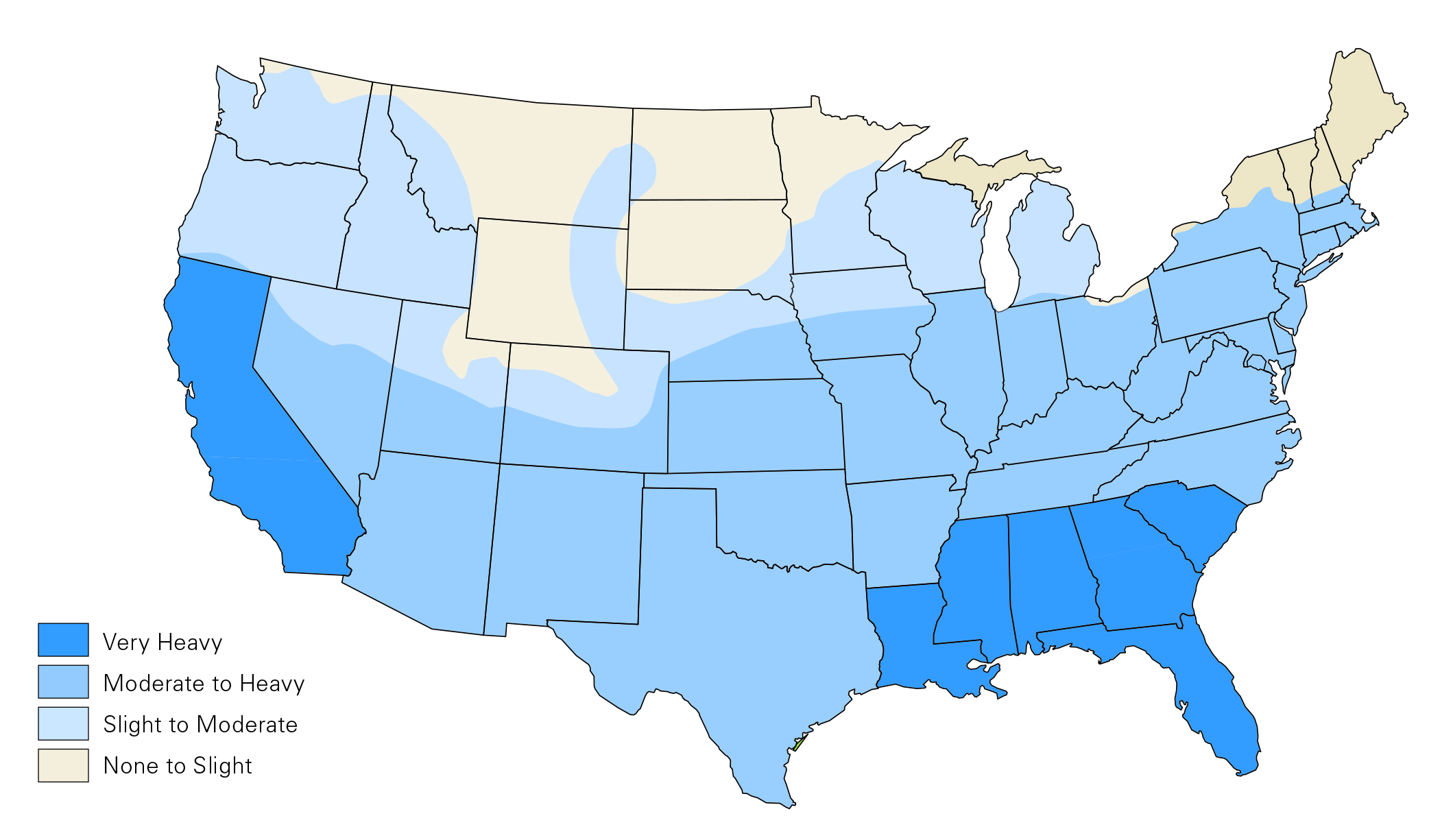
Termite Probability Map Source: 2021 IBC Figure 2603.8 Relative hazard of subterranean termite infestations in the United States
Western red cedar’s unique properties make it ideal for weather-resistant applications, including roof shingles, decking, exterior siding, and exterior cladding. The building faces the western Cascade mountain range and has achieved Earth Advantage Gold certification.
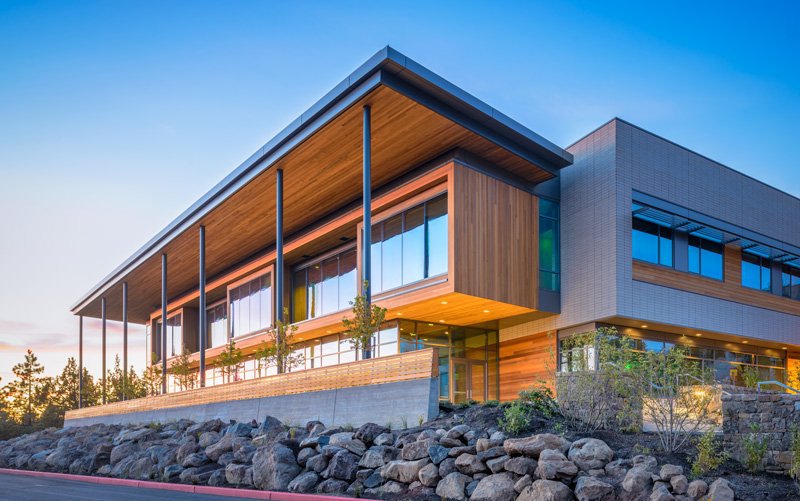
Photo courtesy: Alan Brandt Photography
Central Oregon Community College, Science Center | Pinnacle Architecture.
Wood that is naturally durable for decay and termites, as defined in IBC Chapter 2, includes the heartwood of redwood, Alaska yellow cedar, eastern red cedar, and western red cedar. Preservative-treated wood typically needs to comply with IBC 2303.1.9. Preservative-treated southern pine is distributed throughout much of the United States, while preservative-treated Douglas fir and hem-fir are also commonly distributed in the western states. Preservative treated Douglas fir and hem-fir are often incised to improve their treatment absorption. Because the incising process cuts a small percentage of wood fibers in the lumber, for structural applications, the reduction in strength must be accounted for using the incising factor prescribed by the referenced design standard, the National Design Specification® (NDS) for Wood Construction, available from the American Wood Council.
The required use of treated wood or a naturally durable species is dictated by the proximity of the wood to earth or to concrete in contact with earth.
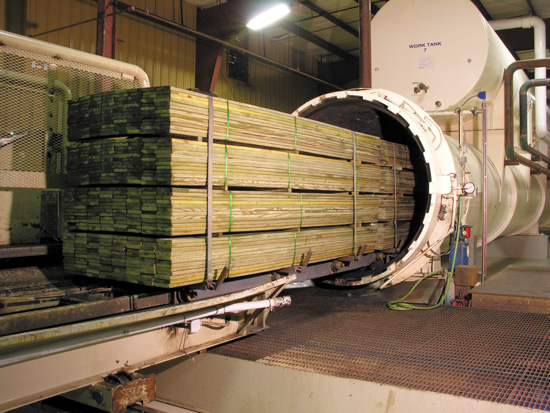
Photo courtesy of BS&S Treated Lumber
The IBC requires specific wood framing members of a building to be protected against decay and termites. Protection can be provided by using either naturally durable or preservative-treated wood.
Sill plates and wood sleepers on concrete in direct contact with the earth, such as a foundation wall or slab-on-grade, require protection. Sills can be protected from moisture migration from the concrete by installation of a sill sealer between the concrete and sill. Such sill sealers are often self-adhesive closed cell foam ribbons installed on the concrete before placing the sill. Not only do sill sealers act as a capillary break for moisture migration, they also serve as an air seal, eliminating potential gaps beneath the sill, and as a small thermal break between the concrete and framing.
In raised floors, wood joists and underlayment are best constructed at least 18 inches from exposed ground and wood girders at least 12 inches from exposed ground. With less clearance, the IBC requires the members to be naturally durable or preservative-treated wood.
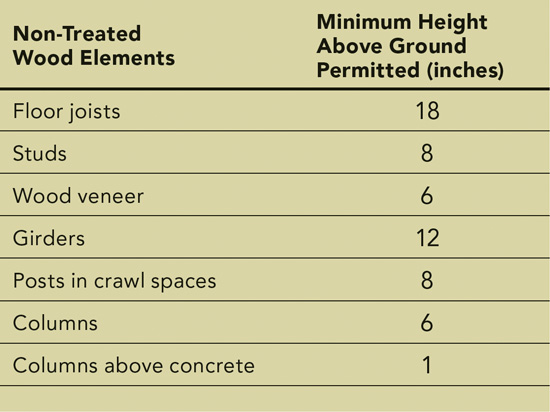
Courtesy of the American Wood Council
Height above ground of non-treated wood elements. Based on the U.S. model building codes and American Wood Council recommendations.
At the exterior of the buildings, it is good practice to provide vertical clearance between the ground and any wood members. A stem wall in a raised floor or a curb made of concrete or masonry on a slab-on-grade foundation can provide the required clearance. Alternatively, the top of a foundation slab is located at an elevation to provide the desired vertical clearance at the exterior edges. Wood framing members, such as studs and wood structural sheathing, are best located at least 8 inches above earth. Below that, IBC 2304.11.2.2 requires wood framing on foundation walls to be naturally durable or preservative-treated wood.
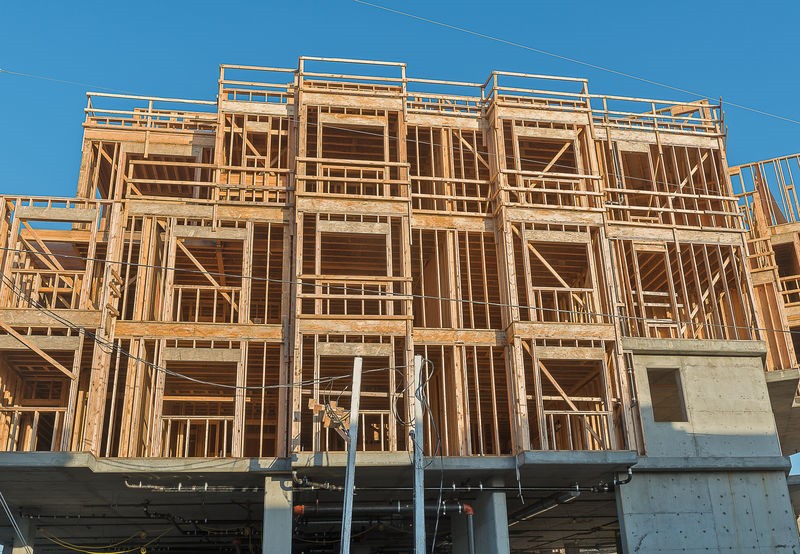
Podium Construction: An Alternative Approach to Termite Protection
In podium construction multiple stories of light wood framing are built over a single or multi-story concrete podium. This method can increase termite protection if the poured concrete level is left exposed. Instead of traditional code requirements, which entail 6 to 8 inches of clearance, a single-story podium creates between 10 and 15 feet of clearance between the wood framing and ground. Using podium construction’s enhanced clearance prevents termite access, eliminates the issue of having soil or landscaping encroach on the clearance over time, and simplifies inspection. For geographic areas that are prone to flooding, podium construction also facilitates a quicker drying process for wood-frame stories after a storm. Depending on region and hazard assessment, using the podium construction method can create enough reduction in risk to choose wood-frame construction in termite-prone areas, allowing building owners to benefit from wood construction’s economy, design flexibility, construction speed, and light carbon footprint.
Design Note: If the podium level is covered with brick or other cladding, minimum clearance would be needed to allow proper inspection, just like a non-podium structure.









